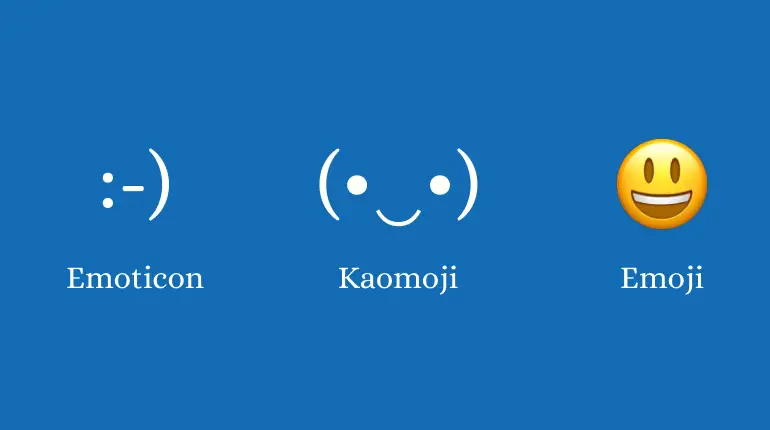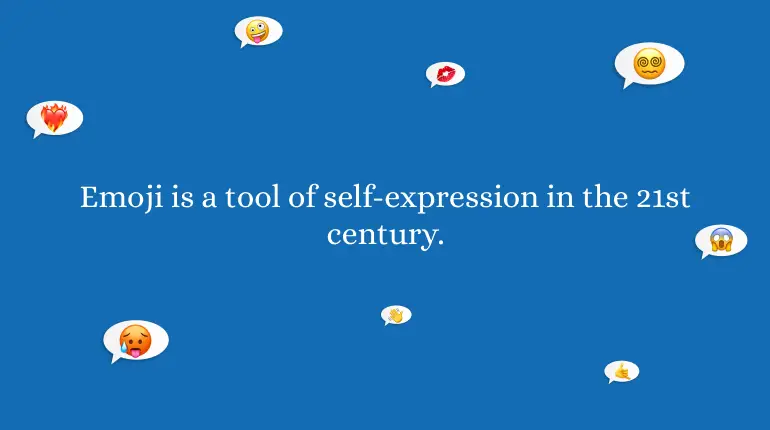Do we need emojis?
It's hard to find now a text message that doesn't contain an emoji. In the US alone, more than half of all Internet users use emoticons in text messages, and teenagers and people under 30 send up to 100 emoticons a day. So what is the phenomenon behind the ever-increasing popularity of emoji and why do we need them? Let's find out below, starting with the story.
In the digital form similar emoji appeared in the 1970s in the computer system PLATO IV. However, these emoji were not designed to communicate. Therefore, the creator of the symbols that transmit emotions and replace words in correspondence is a scientist-programmer Scott Fahlman, who invented emoticons in 1982.
Fahlman’s emoticons contained brackets, colons and hyphens, and initially expressed only two emotions: joy and dissatisfaction. But gradually there were more icons, and they were built into the structure of the text rather than acting as an illustration of what was written.
The punctuation style was picked up in Japan, introducing emoticons in the ASCII NET online service in 1986. There, they were made larger, placed vertically and called kaomoji.
And in 10 years the idea with funny faces was further developed by Nicolas Loufrani, who developed hundreds of new emoticons, made them in colors, divided them into categories, officially registered the copyright and uploaded them to the internet as gif graphics.

Emoji evolution
In 1997, the first SkyWalker DP-211 SW mobile phone appeared, which supported a set of 90 emojis as part of the font. These were monochrome drawings of 12×12 pixels divided into several categories. However, due to its high price, the model did not become mass-produced.
Two years later, Japanese engineer Kurita came up with a collection of 176 emoji for NTT DOCOMO phones on the i-mode platform. The striking designs included facial expressions and were presented as icons to facilitate communication. And it was this set that is considered to be the ancestor of today's emoji.
According to a survey, 80% of emoji supporters in the US use them with friends. Otherwise, emoji help establish contact between interlocutors and maintain further communication. This is according to a 2017 research by linguist Marcel Danezi, who studied the semiotics of emoji.
For example, a smiling emoji placed as a greeting strengthens friendships even when there is negativity in the text. Using emoji as saying goodbye reinforces a good relationship, and using emoticons to fill pauses can offset possible awkwardness and discomfort.

Self expression by means of emoji
Emojis are used to share joy, declare love and often express consent. And judging by the global ranking of emoji popularity and the list of Americans' top favorite emojis, these feelings predominate in correspondence. Proof of this is the leadership of 😂 "Face with tears of joy", ❤️ "Red heart" and 👍 "Thumbs up”.
Emojis are also a significant part of pop culture. Emojis are displayed in museums, movie characters speak in emoji and books are published. As a proof of this are the Original NTT DOCOMO emoji collection on display at New York's Museum of Modern Art, characters from 'Samurai Jack' and an emoji version of 'Moby Dick’.
So why do people use emoji? Here are the main reasons:
Birth and evolution of emojis
The origins of the emoji are sometimes attributed to ancient cave paintings that people used to leave messages on. The first emoji to appear in a written document, researchers say, is a drawing by Jan Ladislades, which the 15th-century lawyer left next to his personal signature in 1635.In the digital form similar emoji appeared in the 1970s in the computer system PLATO IV. However, these emoji were not designed to communicate. Therefore, the creator of the symbols that transmit emotions and replace words in correspondence is a scientist-programmer Scott Fahlman, who invented emoticons in 1982.
Fahlman’s emoticons contained brackets, colons and hyphens, and initially expressed only two emotions: joy and dissatisfaction. But gradually there were more icons, and they were built into the structure of the text rather than acting as an illustration of what was written.
The punctuation style was picked up in Japan, introducing emoticons in the ASCII NET online service in 1986. There, they were made larger, placed vertically and called kaomoji.
And in 10 years the idea with funny faces was further developed by Nicolas Loufrani, who developed hundreds of new emoticons, made them in colors, divided them into categories, officially registered the copyright and uploaded them to the internet as gif graphics.

In 1997, the first SkyWalker DP-211 SW mobile phone appeared, which supported a set of 90 emojis as part of the font. These were monochrome drawings of 12×12 pixels divided into several categories. However, due to its high price, the model did not become mass-produced.
Two years later, Japanese engineer Kurita came up with a collection of 176 emoji for NTT DOCOMO phones on the i-mode platform. The striking designs included facial expressions and were presented as icons to facilitate communication. And it was this set that is considered to be the ancestor of today's emoji.
Using emojis in the 21st century
Smiley faces are everywhere in online texting. They indicate emotional states and moods, act as a way of communicating facial expressions, intonation and gestures that reinforce the context of the message, help avoid ambiguity and play the role of emotional punctuation.According to a survey, 80% of emoji supporters in the US use them with friends. Otherwise, emoji help establish contact between interlocutors and maintain further communication. This is according to a 2017 research by linguist Marcel Danezi, who studied the semiotics of emoji.
For example, a smiling emoji placed as a greeting strengthens friendships even when there is negativity in the text. Using emoji as saying goodbye reinforces a good relationship, and using emoticons to fill pauses can offset possible awkwardness and discomfort.

Emojis are used to share joy, declare love and often express consent. And judging by the global ranking of emoji popularity and the list of Americans' top favorite emojis, these feelings predominate in correspondence. Proof of this is the leadership of 😂 "Face with tears of joy", ❤️ "Red heart" and 👍 "Thumbs up”.
Emojis are also a significant part of pop culture. Emojis are displayed in museums, movie characters speak in emoji and books are published. As a proof of this are the Original NTT DOCOMO emoji collection on display at New York's Museum of Modern Art, characters from 'Samurai Jack' and an emoji version of 'Moby Dick’.
So why do people use emoji? Here are the main reasons:
- Emojis make it easier to express yourself. 91% of US users agree on this, as a recent Adobe survey shows. Emojis make it easier to translate your inner state and show the real you, and it helps you accept any emotion and avoid emotional burnout.
- Emoticons make communication fun and relaxed, and people who add emoji in text seem friendlier. The survey found that 68% and 73% of US users think so, respectively. And millennials are the most likely to claim friendliness. Also, 9 out of 10 emoji fans confirm that they use them to ease the tone of a conversation.
- Emojis are better than text. The majority of U.S. users, 61% on average, are more comfortable expressing their emotions with emojis than with text. And Generation Z and millennials account for 69% of that number. Another 56% would rather send an emoji than talk on the phone, and 50% would do so instead of in person.
- Emojis are not words. Sometimes it's hard to convey excitement, sarcasm or intrigue with letters. Even an exclamation point doesn't solve the situation. It is even more difficult to describe emotion if there is a language barrier. But it all works better when emoji are used instead of words and phrases. That's probably why nearly half of all American users do it. 92% of people in the US use emoticons to help themselves communicate across language barriers.
- Emojis improve mental health. In North America, 60% of those who prefer emoticons in communication agree with this. Equally important, 88% of US users send emoji to express support for the person they are talking to, thereby having a positive impact on their mental health.

